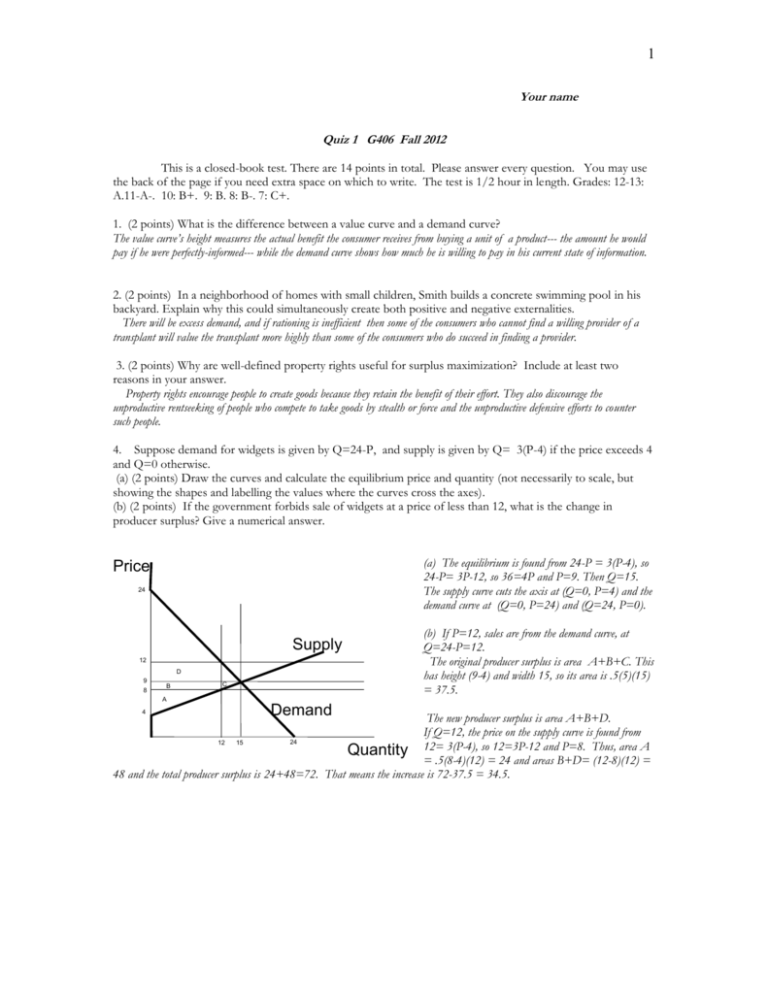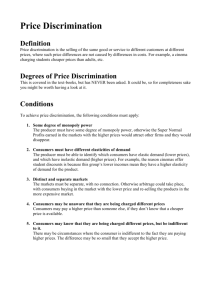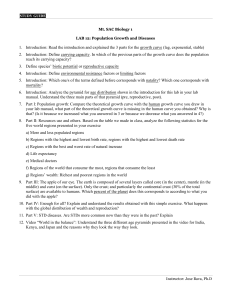quiz1.fall2012.answe..
advertisement

1 Your name Quiz 1 G406 Fall 2012 This is a closed-book test. There are 14 points in total. Please answer every question. You may use the back of the page if you need extra space on which to write. The test is 1/2 hour in length. Grades: 12-13: A.11-A-. 10: B+. 9: B. 8: B-. 7: C+. 1. (2 points) What is the difference between a value curve and a demand curve? The value curve’s height measures the actual benefit the consumer receives from buying a unit of a product--- the amount he would pay if he were perfectly-informed--- while the demand curve shows how much he is willing to pay in his current state of information. 2. (2 points) In a neighborhood of homes with small children, Smith builds a concrete swimming pool in his backyard. Explain why this could simultaneously create both positive and negative externalities. There will be excess demand, and if rationing is inefficient then some of the consumers who cannot find a willing provider of a transplant will value the transplant more highly than some of the consumers who do succeed in finding a provider. 3. (2 points) Why are well-defined property rights useful for surplus maximization? Include at least two reasons in your answer. Property rights encourage people to create goods because they retain the benefit of their effort. They also discourage the unproductive rentseeking of people who compete to take goods by stealth or force and the unproductive defensive efforts to counter such people. 4. Suppose demand for widgets is given by Q=24-P, and supply is given by Q= 3(P-4) if the price exceeds 4 and Q=0 otherwise. (a) (2 points) Draw the curves and calculate the equilibrium price and quantity (not necessarily to scale, but showing the shapes and labelling the values where the curves cross the axes). (b) (2 points) If the government forbids sale of widgets at a price of less than 12, what is the change in producer surplus? Give a numerical answer. (a) The equilibrium is found from 24-P = 3(P-4), so 24-P= 3P-12, so 36=4P and P=9. Then Q=15. The supply curve cuts the axis at (Q=0, P=4) and the demand curve at (Q=0, P=24) and (Q=24, P=0). Price 24 Supply 12 D 9 8 B C (b) If P=12, sales are from the demand curve, at Q=24-P=12. The original producer surplus is area A+B+C. This has height (9-4) and width 15, so its area is .5(5)(15) = 37.5. A 4 Demand The new producer surplus is area A+B+D. If Q=12, the price on the supply curve is found from 24 12 15 Quantity 12= 3(P-4), so 12=3P-12 and P=8. Thus, area A = .5(8-4)(12) = 24 and areas B+D= (12-8)(12) = 48 and the total producer surplus is 24+48=72. That means the increase is 72-37.5 = 34.5. 2 5. If unregulated, paper manufacturing creates water pollution. Suppose that if paper sales are Q then the cost of the water pollution to people downstream is 3Q, and that supply and demand take their conventional moderately price-elastic shapes. (a) (2 points) Draw a diagram to show the levels of paper sales under laissez faire equilibrium and under optimal regulation. (b) (2 points) Show how much total surplus increases going from laissez faire to optimal regulation, and how the total cost of water pollution changes. . Social Cost Price C A B Supply Demand Q(reg) Q(no reg.) Quantity (a) The cost of the water pollution to people downstream is 3 per unit of paper sold; if amount Q is sold, the cost is 3Q. Thus, the social cost is always 3 higher than the supply curve, as shown in the diagram above. The supply and demand curves take their typical shapes, neither being perfectly elastic (flat). The initial output is where the supply and demand curves cross, Q(no reg.). The optimal regulation would reduce sales to Q(reg.), where the marginal social cost crosses the demand curve. (b) Total surplus increases by area C going from laissez faire to optimal regulation, because the units between Q(reg) and Q(no reg.) have a social cost in excess of the their social benefit, the height of the demand curve. The pollution cost to third parties is the area between the social cost curve and the supply curve. That is area A+B+C under laissez faire, since output is Q(no reg.), and it falls to area A under regulation.





